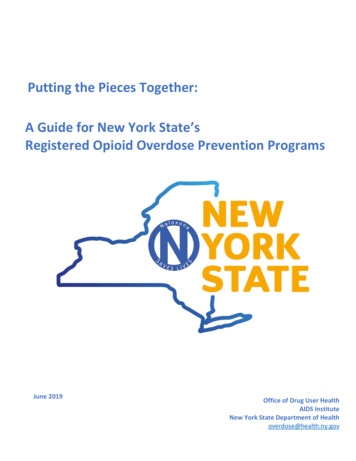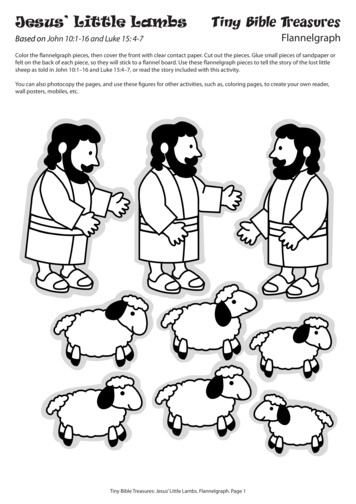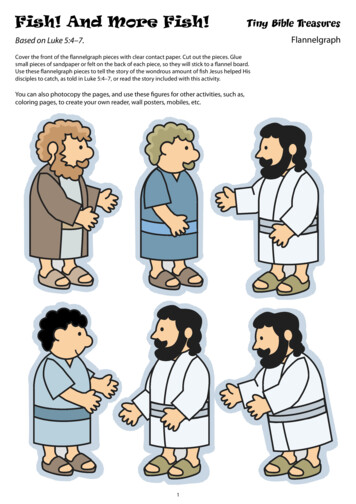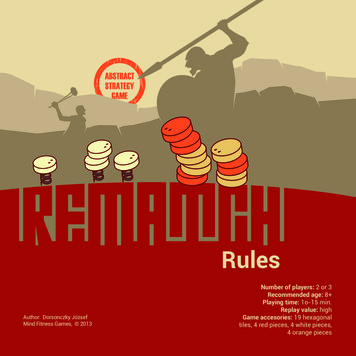
Transcription
Putting the Pieces Together:A Guide for New York State’sRegistered Opioid Overdose Prevention ProgramsJune 2019Office of Drug User HealthAIDS InstituteNew York State Department of Healthoverdose@health.ny.gov
Putting the Pieces Together:A Guide for New York State’s Registered Opioid Overdose Prevention ProgramsTHIS PAGE INTENTIONALLY LEFT BLANK
Putting the Pieces Together:A Guide for New York State’s Registered Opioid Overdose Prevention ProgramsTABLE OF CONTENTSOVERVIEW. 3REGISTRATION . 3TWO-YEAR RECERTIFICATION . 4OPIOID OVERDOSE PROGRAM STAFFING .5PROGRAM DIRECTOR . 5CLINICAL DIRECTOR . 6AFFILIATED PRESCRIBERS . 7APPROVED OVERDOSE TRAINERS (AOTS) . 7TRAINED OVERDOSE RESPONDERS (TORS) . 9STANDING ORDERS . 9TRAINING . 10CORE CURRICULUM FOR COMMUNITY RESPONDERS . 10TAILORING TRAINING TO THE AUDIENCE . 11REFRESHER TRAININGS FOR TORS . 11TRAINING APPROVED OVERDOSE TRAINERS (AOTS) TO TRAIN RESPONDERS AND FURNISH NALOXONE . 11MATERIALS PROVIDED TO TRAINED OVERDOSE RESPONDERS (RESCUE KIT CONTENTS) . 12CERTIFICATE OF COMPLETION . 12NALOXONE . 12INTRAMUSCULAR SYRINGES . 13FACE SHIELD FOR RESCUE BREATHING . 13ALCOHOL WIPES . 13INSTRUCTIONS ON OPIOID OVERDOSE RECOGNITION AND RESPONSE . 13ZIPPERED NYLON BAG FOR HOLDING KIT CONTENTS . 13MANDATED REPORTING . 14QUARTERLY REPORTING . 14NALOXONE ADMINISTRATION REPORTING . 14MANDATED RECORD KEEPING. 15INVENTORY CONTROLS AND SUPPLY MANAGEMENT . 15RECORD-KEEPING TO SUPPORT MANDATED REPORTING. 15RECORDS PERTAINING TO TRAINED OVERDOSE RESPONDERS . 15RECORDS PERTAINING TO APPROVED OVERDOSE TRAINERS . 16RECORDS PERTAINING TO ORDERING NALOXONE . 16ORDERING OPIOID OVERDOSE SUPPLIES . 17APPENDICES .IAPPENDIX A: NEW YORK STATE PUBLIC HEALTH LAW SECTION 3309 . IAPPENDIX B: NEW YORK CODES, RULES AND REGULATIONS, TITLE 10 SECTION 80.138 .IIIAPPENDIX C: NEW YORK STATE EDUCATION LAW SECTION 6509-D. VIIIAPPENDIX D: CERTIFICATE OF APPROVAL . IXAPPENDIX E: DETAILED OUTLINE OF TRAINING FOR TRAINED OVERDOSE RESPONDERS (TORS) . XIAPPENDIX F: CERTIFICATE OF COMPLETION . XVAPPENDIX G: NALOXONE FORMULATIONS . XVIAPPENDIX H: REASONS FOR POSSIBLE TERMINATION OF A REGISTRATION . XVIIAPPENDIX I: MAXIMIZING USE OF PHARMACIES AS A SOURCE OF NALOXONE FOR TORS . XVIIIJune 2019Page 1
Putting the Pieces Together:A Guide for New York State’s Registered Opioid Overdose Prevention ProgramsAPPENDIX J: GUIDANCE FOR OPIOID OVERDOSE PREVENTION PROGRAMS IN SPECIALIZED SETTINGS .XXSyringe Exchange Programs . xxEmergency Room, Primary Care and Opioid Treatment Settings .xxiAPPENDIX K: GUIDANCE AND LEGAL FRAMEWORK FOR SPECIALIZED OVERDOSE RESPONDERS . XXIIILaw Enforcement Personnel. xxiiiFire Fighters . xxiiiSecondary School and Board of Cooperative Educational Services (BOCES) Personnel . xxivLicensed Professionals as Trained Overdose Responders. xxvEmergency Medical Services (EMS) personnel . xxvAPPENDIX L: COMMUNITY (NON-PUBLIC SAFETY) NALOXONE ADMINISTRATION REPORTING FORM . XXVIAPPENDIX M: PUBLIC SAFETY NALOXONE ADMINISTRATION FORM . XXVIIIAPPENDIX N: SAMPLE GENERIC ENROLLMENT FORM . XXIXGLOSSARY OF ABBREVIATIONSAOT.Approved Overdose TrainerBLS .Basic Life SupportBOCES .Board of Cooperative Educational ServicesEMS .Emergency Medical ServicesNYC .New York CityNYCDOHMH .New York City Department of Health and Mental HygieneNYCRR .New York Codes, Rules and RegulationsNYS .New York StateNYSDOH .New York State Department of HealthNYSOOPPS .New York State Opioid Overdose Prevention Program SystemPHL .New York State Public Health LawTOR .Trained Overdose ResponderJune 2019Page 2
Putting the Pieces Together:A Guide for New York State’s Registered Opioid Overdose Prevention ProgramsOverviewThis document provides New York State Department of Health (NYSDOH)-approved opioid overdose preventionprograms with guidance on delivering services consistent with New York Public Health Law (PHL) Section 3309 1 and10 NYCRR 80.138 2. It should be used by registered programs to tailor their policies and procedures and developtraining programs.There are additional statutes, regulations and guidance documents which are relevant for overdose training andnaloxone provision in various specialized settings and for specialized responders. Registered opioid overdoseprevention programs planning on working with law enforcement, fire fighters, secondary school and BOCESpersonnel and Basic Life Support EMS agencies should review the Guidance and Legal Framework for SpecializedOverdose Responders. 3 This guidance document should be reviewed annually. Check www.health.ny.gov/overdose for the most currentversion.Policies and procedures and curricula must be consistent with the laws and regulations, as well as with guidanceprovided by the NYSDOH. If there any questions about compliance, inquiries should be directed tooverdose@health.ny.gov.New York State’s Drug User Health Center of Excellence may also be consulted for guidance through an email tooverdose@health.ny.gov.Every registered program’s policies and procedures and training protocols should be reviewed annually toensure they reflect good practice and meet the needs of the persons being served.RegistrationAll regulated opioid overdose prevention programs must have an active registration with the NYSDOH. 4Registration is limited to the eligible entities specified in the regulations. 5Central to each program’s registration is the designation of: Key staff, including the Program Director and the Clinical Director; Addresses where routine program activities will take place; and Who the Trained Overdose Responders (TORs) will be.Registration forms are completed and submitted on the New York State Opioid Overdose Prevention ProgramSystem (NYSOOPPS). Once an electronic registration is submitted, a printed version must be signed by the ProgramDirector and the Clinical Director and then mailed to the NYSDOH as instructed in the online registration process. 6Once a program registration is approved, the Program Director and the Clinical Director will receive notification thata Certificate of Approval 7 has been issued. The Certificate of Approval remains in effect for two years. A programAppendix AAppendix B3Appendix K410 NYCRR 80.138(b)510 NYCRR 80.138(a)(5)(i-viii)6Further guidance on registration completion is found at www.health.ny.gov/overdose. Assistance may also besought by sending an email to overdose@health.ny.gov.7Appendix D: Certificate of Approval12June 2019Page 3
Putting the Pieces Together:A Guide for New York State’s Registered Opioid Overdose Prevention Programsmay terminate its registration at any time with notification to the NYSDOH through an email tooverdose@health.ny.gov. The NYSDOH may also terminate a registration with written notification to the program. 8A single registration may cover multiple addresses, all of which should be reflected within the registration. Overdosesupplies, including naloxone, may be shipped to these addresses, however the Clinical Director must authorizeaddresses for naloxone shipments. In special circumstances, an eligible entity may maintain more than oneregistered program, each of which will be assigned a distinct certificate number. Maintaining multiple registrationsshould be restricted to instances in which there are administratively distinct or are separately managed units.Merely having multiple program locations is not a good rationale for an organization to have multiple registrations.The information related to an entities registration should be reviewed quarterly by the Program Director and theClinical Director to ensure that it is accurate. This quarterly review on the NYSOOPPS is ideally done at the sametime as mandated quarterly reporting. Changes to registration information can be made either directly on theNYSOOPPS or through an email to overdose@health.ny.gov.Because of staff turnover—including perhaps of both the Program Director and the Clinical Director—registeredprograms should ensure that there are policies and procedures in place so that individuals other than the ProgramDirector and the Clinical Director know to inform the NYSDOH of staff departures and replacements. Those changesin registration information should be conveyed in an email to overdose@health.ny.gov.Two-year RecertificationTwo months prior to the expiration of a two-year Certificate of Approval, the Program Director should access theNYSOOPPS and review all information pertaining to the program’s registration including the following: Names and contact information for the Program Director and the Clinical Director; Current licensure information for the Clinical Director (and Affiliated Prescribers, if any); and Names and addresses for all sites at which there is routine program activity.Confirmation that information in NYOOPS is correct or notification of necessary changes should be communicated inan email from the Program Director to overdose@health.ny.gov. That email should also indicate that the programwants to be recertified for an additional two years.The NYSDOH recertifies programs every two years at its discretion. If a program is not in good standing, it will not berecertified. 9 At the time of recertification and throughout the course of a registration, the NYSDOH will review theregistered program’s history of mandated quarterly data reporting and its history of ordering supplies. The quantityof naloxone ordered should be reflected in the quantity of naloxone furnished to trained responders.Programs should not submit a new registration form for recertification or for changing registration information.89See Appendix H: Reasons for Possible Termination of a Registration.See Appendix H: Reasons for Possible Termination of a Registration.June 2019Page 4
Putting the Pieces Together:A Guide for New York State’s Registered Opioid Overdose Prevention ProgramsOpioid Overdose Program StaffingAll registered opioid overdose programs are required to have two positions: a Program Director and a ClinicalDirector. The same individual may serve in both capacities; however, it is recommended that two individuals fillthese roles to manage the responsibilities outlined in the regulations and in this guidance document. Someprograms may also choose to have Affiliated Prescribers and Approved Overdose Trainers (AOTs). The individualstrained by registered programs are known as Trained Overdose Responders (TORs). Each of the positions isdescribed below.Program DirectorDescription and QualificationsThe Program Director has overall responsibility for the Opioid Overdose Prevention Program. 10, 11 Each registeredprogram has only one Program Director. The Program Director must be an employee or a contracted agent of theorganization maintaining the registration.Roles and responsibilitiesThe Program Director is the registered program’s primary contact for the NYSDOH. The Program Director’sresponsibilities, many of which can be delegated, include the following: Identifying a New York State-licensed physician, physician assistant or nurse practitioner to serveas the program’s Clinical Director; Implementing a curriculum approved by the NYSDOH 12; Maintaining appropriate record keeping systems 13 for facilitating compliance with the mandatedreporting requirements 14; Selecting AOTs in consultation with the Clinical Director and overseeing these AOTs to ensure theyare competent in delivering trainings and furnishing naloxone, when naloxone is furnished under astanding order 15; Having a validated account on the NYSOOPPS and creating additional accounts for other programstaff, if those other accounts are appropriate for helping manage the program; Electronically signing the “Terms and Conditions” and the “NYS Release” on the NYSOOPPS ifNarcan nasal spray is to be ordered from the NYSDOH; Ensuring that there is a valid “ship to” address on the NYSOOPPS for the delivery of opioidoverdose supplies ordered through the NYSDOH; Sending an email to overdose@health.ny.gov or using the NYSOOPPS to notify the NYSDOH ofimpending changes in: Program Director; Clinical Director or licensure; Affiliated Prescribers; Program sites; and Anything that may impede program operations. Ordering opioid overdose supplies, or reviewing orders submitted made by other authorizedprogram personnel 16;10 NYCRR 80.138(a)(6)10 NYCRR 80.138(c)(1)12See Core Curriculum for Community Responders and Appendix E: Detailed Outline of Training for TORs.13See Mandated Record Keeping14See Mandated Reporting15See Supervision of Approved Overdose Trainers and Standing Orders.16See Ordering Opioid Overdose Supplies1011June 2019Page 5
Putting the Pieces Together:A Guide for New York State’s Registered Opioid Overdose Prevention Programs Maintaining an inventory of opioid overdose supplies and having appropriate inventory controls 17;Submitting quarterly reports to the NYSDOH through the NYSOOPPS 18; andSubmitting naloxone administrations reports to the NYSDOH through the NYSOOPPS 19.If the Program Director is also conducting overdose trainings and selectively furnishing naloxone, the ProgramDirector is also responsible for carrying out the duties of an AOT. 20Clinical DirectorDescription and QualificationsThe Clinical Director provides clinical oversight of the program and is the person with primary responsibility forprescribing naloxone for the program’s responders. 21, 22 Those prescriptions are either patient-specific prescriptionsor non-patient specific standing orders. The Clinical Director must be a physician, physician assistant or nursepractitioner whose scope of practice includes the prescription of medication. The Clinical Director does not need tobe an employee of the organization maintaining the overdose program, but there should be documentationsupporting the relationship between the Clinical Director and that organization. There is only one Clinical Directorfor each registered program.Roles and responsibilitiesIn addition to providing clinical oversight and prescribing naloxone, the Clinical Director’s responsibilities include: Working with the Program Director to: Ensure that all overdose responders are properly trained; Develop or adapt—and then implement—an opioid overdose prevention trainingcurriculum 23; Reviewing naloxone administration reports 24; Having a validated account on the NYSOOPPS and creating, additional accounts, as needed, forother program staff; Electronically signing the “ship to” form on the NYSOOPPS, if orders for Narcan nasal spray willbe placed through the NYSDOH; Reviewing storage and inventory controls for naloxone; Designating and supervising Approved Overdose Trainers (AOTs), if the program model usesthem 25, 26; and Designating Affiliated Prescribers, if any, and maintaining routine and ongoing contact with themto ensure appropriate oversight.If the Clinical Director is also conducting overdose trainings and selectively furnishing naloxone, the ClinicalDirector is also responsible for carrying out the responsibilities of an AOT.See Inventory Controls and Supply ManagementSee Quarterly Reporting19See Naloxone Administration Reporting20See Approved Overdose Trainer/Roles and Responsibilities2110 NYCRR 80.138(a)(7)2210 NYCRR 80.138(c)(2)23See Appendix E: Detailed Outline of Training for Trained Overdose Responders (TORs)2410 NYCRR 80.138(c)(2)(v)2510 NYCRR 80.138(c)(2)(vi)26This may be coordinated with the Program Director.1718June 2019Page 6
Putting the Pieces Together:A Guide for New York State’s Registered Opioid Overdose Prevention ProgramsAffiliated PrescribersDescription and QualificationsAffiliated Prescribers are individuals who, in addition to the Clinical Director, may prescribe naloxone for a registeredprogram’s TORs. 27 Each Affiliated Prescriber must be licensed in New York State as a physician, a nurse practitioneror a physician assistant and have prescribing medication in their scope of practice. Affiliated Prescribers do not needto be employees of the organization maintaining the overdose program. There may be multiple AffiliatedPrescribers.The Clinical Director in consultation with the Program Director selects Affiliated Prescribers who are designatedeither in a program’s initial registration or in a subsequent notification to the NYSDOH through the NYSOOPPS orthrough an email to overdose@health.ny.gov.Roles and responsibilitiesIn addition to prescribing naloxone, they are responsible for: Coordinating their program-related activities closely with the Clinical Director; Ensuring that any training or naloxone dispensing done by the Affiliated Prescriber becomes partof the registered program’s records in a timely way; Reporting program-related activities to the Clinical Director; and Supervising Approved Overdose Trainers (AOTs) if that role is delegated to them by the ClinicalDirector.If Affiliated Prescribers are also conducting overdose trainings and selectively furnishing naloxone, they are alsoresponsible for carrying out the responsibilities of an AOT.When are Affiliated Prescribers Advisable?Affiliated Prescribers are optional. They may not be necessary if a program’s naloxone furnishing is done solelyunder a standing order from the Clinical Director. Affiliated Prescribers may be helpful to some programs in thefollowing situations: If the program chooses only to issue patient-specific prescriptions for naloxone; If there are multiple clinical settings in which local clinical oversight of the overdose program sitesis deemed appropriate by the program; If there is a large and changing set of AOTs, and having Affiliated Prescribers provides helpfulcapacity for overseeing their work; or If the clinical environment of the program is that such that multiple prescribers are helpful insupporting the program’s operations.Approved Overdose Trainers (AOTs)DescriptionAOTs train TORs. These are individuals designated by the Clinical Director in consultation with the Program Directorto provide opioid overdose training and to selectively furnish naloxone pursuant to a non-patient specificprescription (standing order) issued by the Clinical Director. A registered program may designate its AOTs byanother name such as “Approved Dispensers”.2710 NYCRR 80.138(a)(8)June 2019Page 7
Putting the Pieces Together:A Guide for New York State’s Registered Opioid Overdose Prevention ProgramsQualificationsAOTs are encouraged to complete a train-the-trainer session delivered by the New York State Drug User HealthCenter of Excellence, the Program Director, the Clinical Director or by someone else with strong, broad competencyin opioid overdose recognition and response. They do not need to be staff of the registered program.Roles and responsibilitiesAn AOT has the following responsibilities: Delivering the core curriculum for community responders 28; Having sufficient knowledge to respond to frequently asked questions raised by trainedresponders; Tailoring the training session so it is responsive to the setting and the audience; Demonstrating naloxone device preparation, if any, and administration; Verifying that trained responders understand core curriculum content, including overdoserecognition and naloxone administration; Handling the logistics for conducting a training including having the following available: Training materials; Certificates of Completion; Naloxone: For demonstration; and For furnishing, if naloxone is being provided to TORS as part of thetraining. Directing trained individuals to pharmacies for naloxone, or furnishing naloxone to trainedresponders consistent with the Clinical Director’s standing order, with the program’s policies andprocedures and with the NYSDOH guidance on use of pharmacies 29; Providing a Certificate of Completion to each trained responder, whether they receive naloxoneor not; Creating a record for all trained individuals 30; and Ensuring that all training records are returned to the overdose Program Director or ClinicalDirector consistent with the program’s policies and procedures.Benefits to Having AOTsApproved Overdose Trainers (AOTs) are not required by law or regulation. AOTs, when combined with standingorders help provide naloxone to trained responders without the presence of the Clinical Director or of an AffiliatedPrescriber. They also act as “extenders” for both the Program Director and the Clinical Director.Supervision of Approved Overdose TrainersThe supervision of AOTs should occur at least 4 times a year and may be conducted in-person or by telephone. Thissupervision may also be done in coordination with the Program Director. The supervision should cover: Creating a record for training responders and the provision of naloxone; Storage and inventory maintenance of overdose supplies; and Questions arising in overdose trainings where the AOT can benefit from additional clinical orprogrammatic information.Records on AOTsThere should be a roster of AOTs signed by the Clinical Director with the date on which the AOT was approved.See Core Curriculum for Community RespondersSee Appendix I: Maximizing use of Pharmacies as a Source of Naloxone for TORs30See Records Pertaining to Trained Overdose Responders2829June 2019Page 8
Putting the Pieces Together:A Guide for New York State’s Registered Opioid Overdose Prevention ProgramsTrained Overdose Responders (TORs)Description and QualificationsTrained Overdose Responders are the individuals trained by an AOT, a Program Director, a Clinical Director, anAffiliated Prescriber, a pharmacist or by a clinician as part of patient care to respond to an opioid overdose. Throughthat training, they should have the knowledge and skills to 1) recognize an opioid overdose; 2) call 911; 3)administer naloxone; 4) provide post-naloxone administration support; 5) report their naloxone administrations;and 6) seek replacement naloxone. 31 32Virtually anyone in New York State can be a trained overdose responder. This includes individuals who use opioids;their family members and friends; persons affiliated with healthcare or social service agencies serving persons at riskfor an overdose; public safety personnel (law enforcement officers and fire fighters); school and library staff;university staff and students; supportive housing and shelter
overdose@health.ny.gov. Every registered program's policies and procedures and training protocols should be reviewed annually to ensure they reflect good practice and meet the needs of the persons being served. Registration . All regulated opioid overdose prevention programs must have an active registration with the NYSDOH. 4











